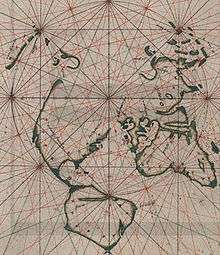João de Lisboa
João de Lisboa (c.1470 – 1525) was a Portuguese explorer. It is known to have sail together with Tristão da Cunha, and to have explored Río de La Plata and possibly the San Matias Gulf, around 1511-12. The Brazilian historian Francisco Adolfo de Varnhagen remarks that he was in Ferdinand Magellan circumnavigation voyage: [1]
- We notice that with Magellan went the portuguese pilot João de Lisboa, which had been in Brazil before, and wrote a book on seamanship, whose appearance would be of transcendence importance to the geographical history.
He is the author of a Treatise of Seamanship that includes 20 remarkable maps and a Treatise on the Nautical Needle, dated by himself in 1514 (1508, in manuscript). [2]
He died in 1525 while traveling in the Indian Ocean.
Treatise of Seamanship
It is composed by the Brief Treatise on Seamanship and a "Treatise on the Nautical Needle found by João de Lisboa in the year 1514", and within its pages there are 20 singular chart maps.


The 20 charts present:
- Chart 1: Newfoundland, Azores, Iceland, England, Lisbon;
- Chart 2: Central America, Antilles Sea, South America northwest;
- Chart 3: Antilles Sea, South America coast from Maracaibo Gulf to Maranhão;
- Chart 4: South America coast, from Rio de Janeiro to the Magellan Strait, with La Plata River;
- Chart 5: Coast from Maranhão to the South of Brazil;
- Chart 6: From the Brazilian northeast to the west of Africa;
- Chart 7: South Atlantic islands;
- Chart 8: North Atlantic, with Bacallaos Land (Newfoundland), Iceland, England, Lisbon;
- Chart 9: Western Europe
- Chart 10: West Africa and Brazilian Northeast.
- Chart 11: Guinea Gulf;
- Chart 12: Western Africa;
- Chart 13: Eastern Africa;
- Chart 14: Southwest islands in the Indian Ocean;
- Chart 15: Red Sear and Persian Gulf;
- Chart 16: From Persian Gulf coast to Sri Lanka;
- Chart 17: Far East from the Siamese Gulf to Japan;
- Chart 18: Bengala Gulf;
- Chart 19: Insulindia;
- Chart 20: Globe of the world - radial representation centered at the North Pole;
The book can be found in Torre do Tombo National Archive (Colecção Cartográfica nº166), with an additional information that the maps are made of parchment.
This date 1514, written by João de Lisboa, conflicts with the knowledge presented in the maps. For instance, the Magellan Strait, or Japan (which was only reported by the Portuguese in 1543, after the death of the author). On the other hand, the position of the Portuguese flags in the World Map is not consistent with events after 1514, nor with any other official account. In one of the charts, Portuguese castles are clearly drawn in Inca territory, something that was never reported in any official document. Armando Cortesão remarks that there are a posteriori inclusions in the charts, and due to the names found in the charts, namely Japan, he is forced to date it "circa 1560", which would imply another author (however he does not explain any further details).[3]

References
- ↑ Francisco Adolfo de Varnhagen (1854). História Geral do Brazil. 1. p. 31.
- ↑ Jonkers, A. R. T. (2003). Earth's Magnetism in the Age of Sail. Baltimore: Johns Hopkins University Press. p. 151. ISBN 0-8018-7132-8.
- ↑ Armando Cortesão; Avelino Teixeira da Mota (1960). Portugalliae Monumenta Cartographica. Lisbon: Imprensa Nacional da Casa da Moeda.